
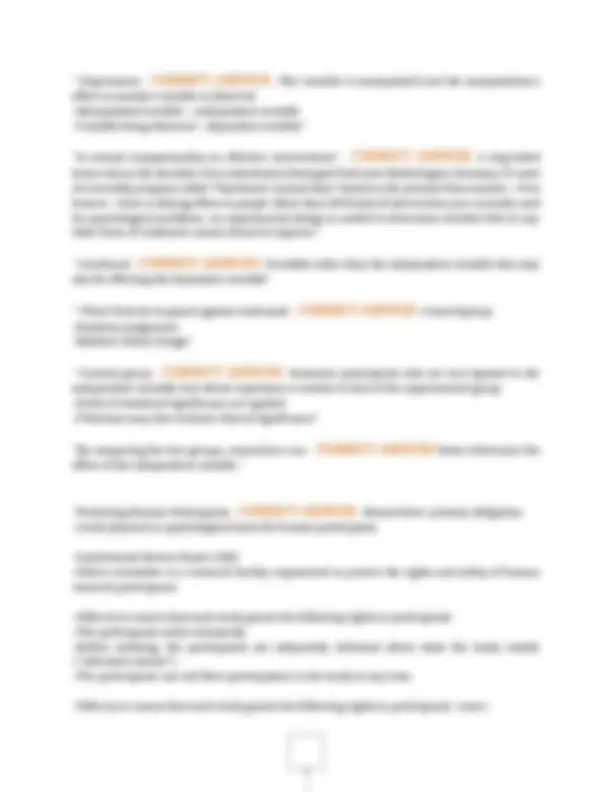
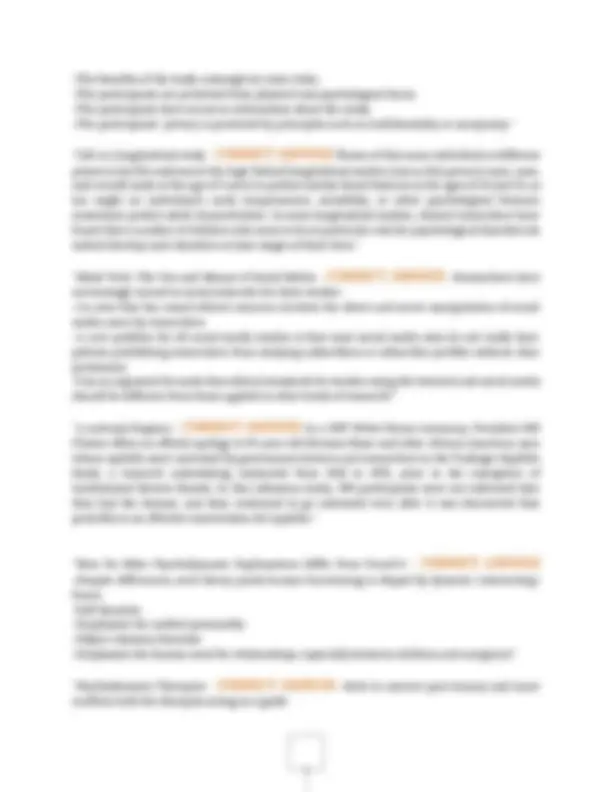
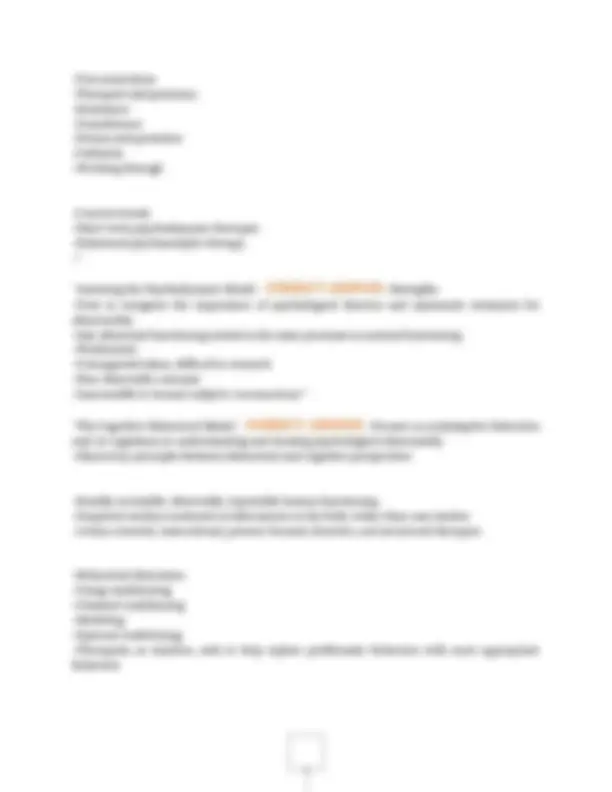
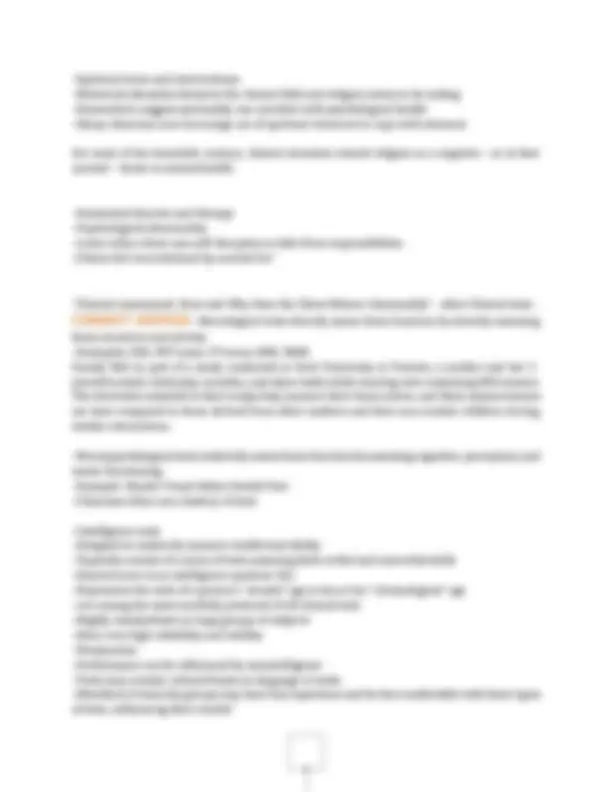
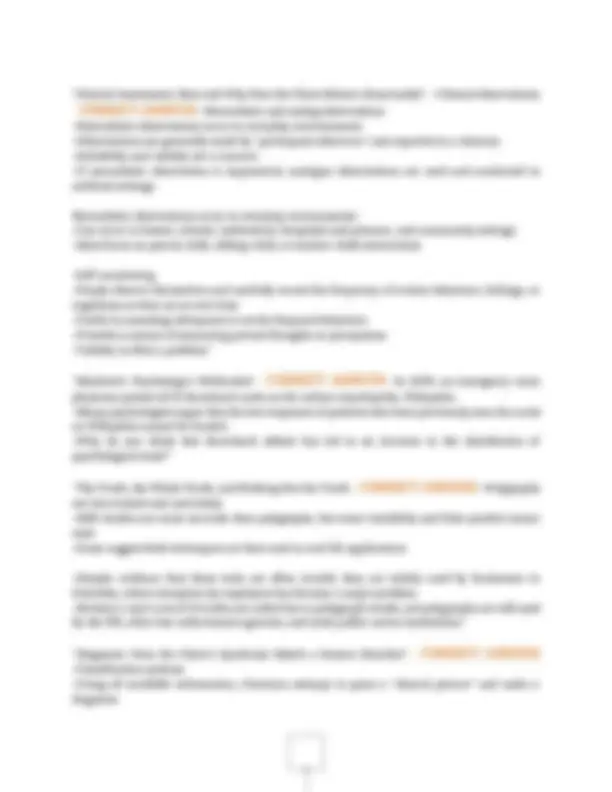
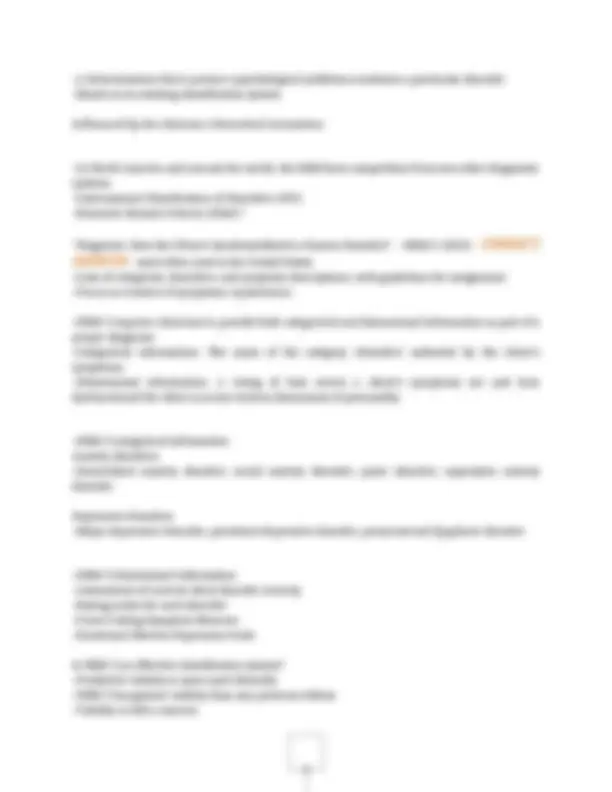
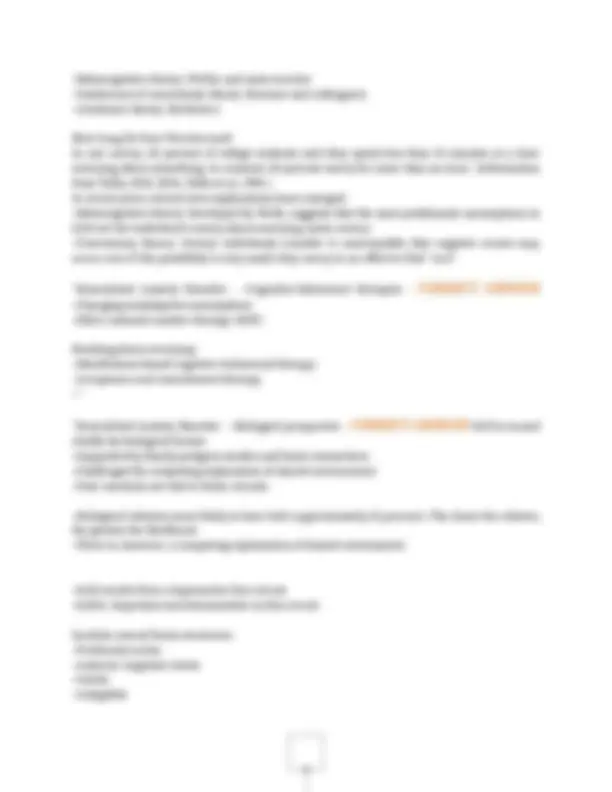
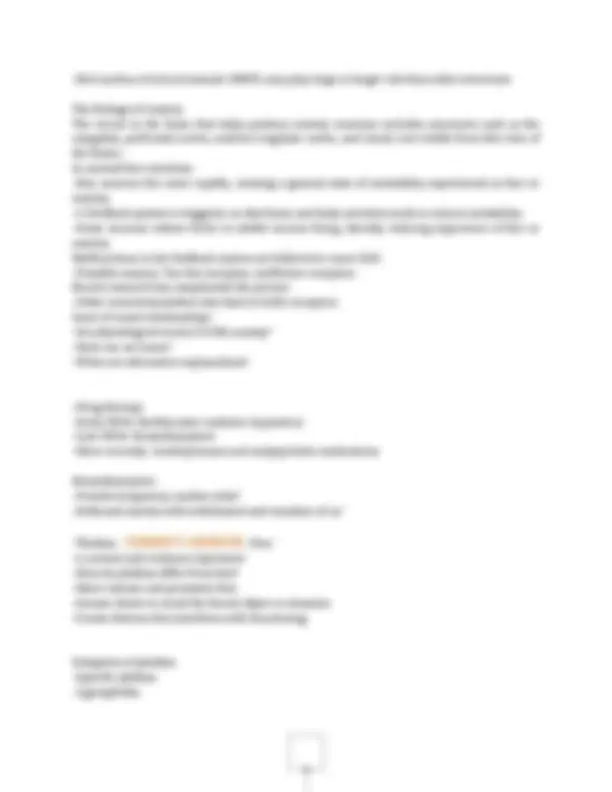

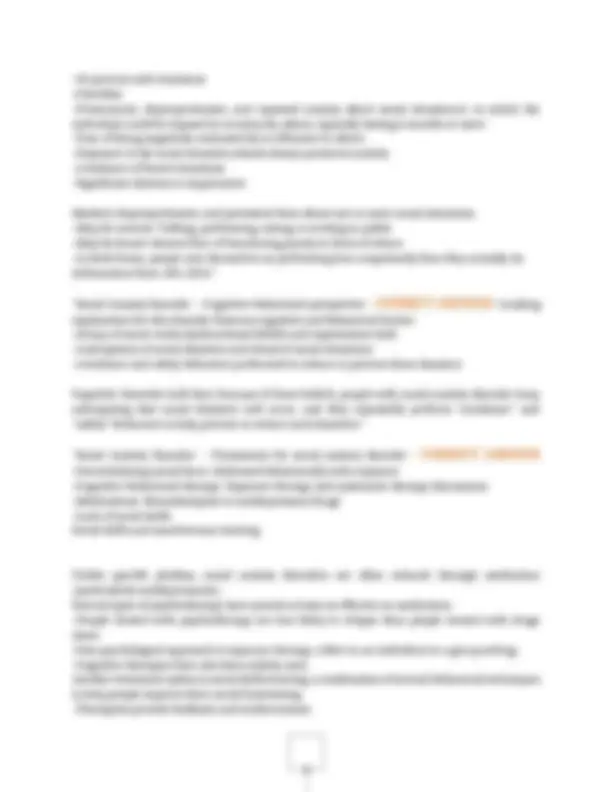
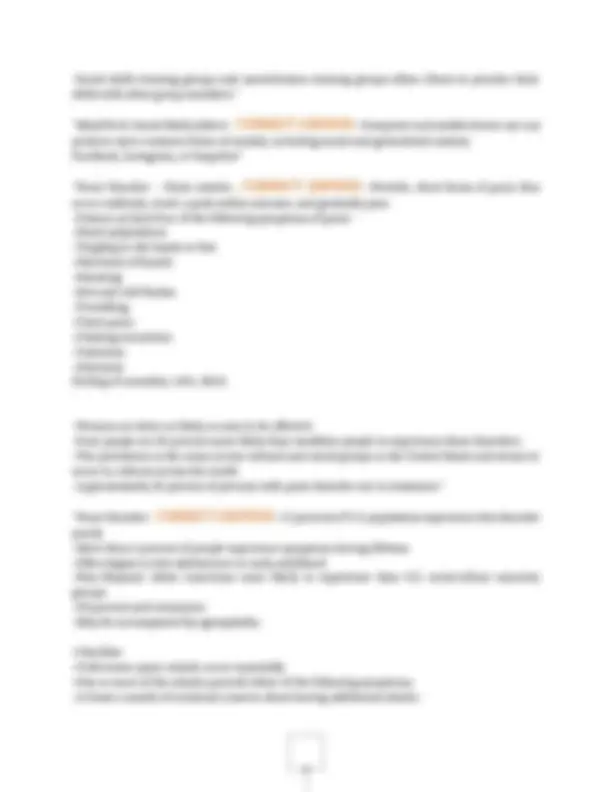
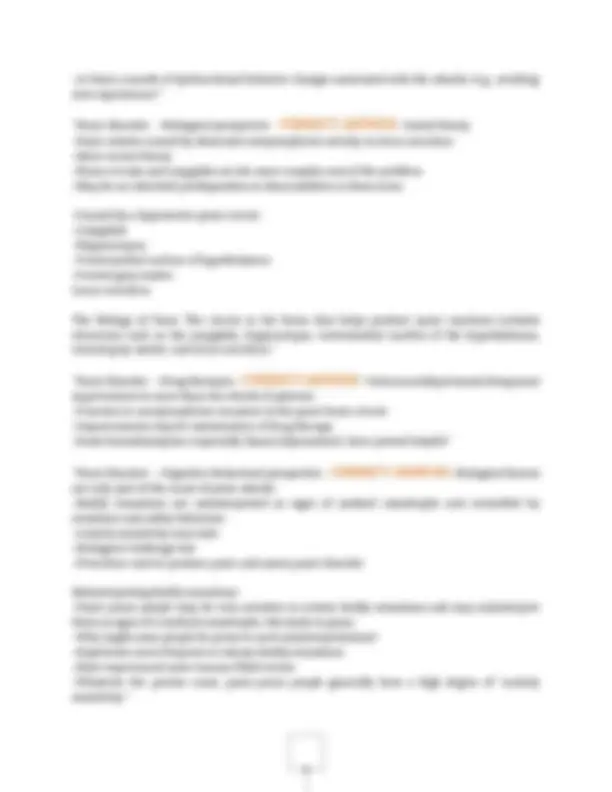
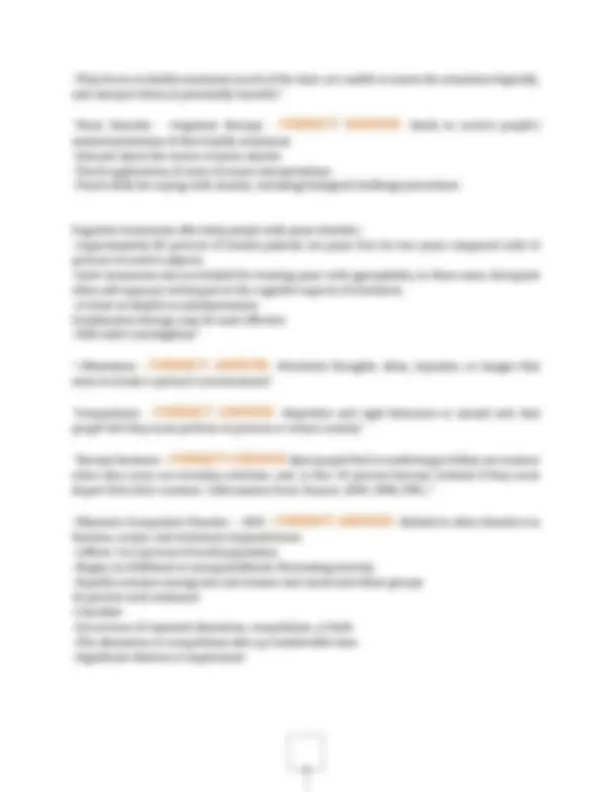
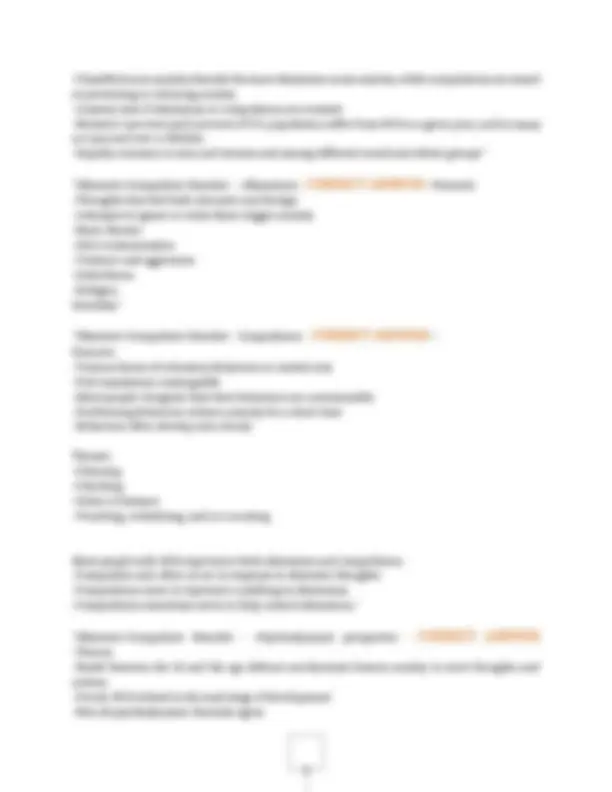
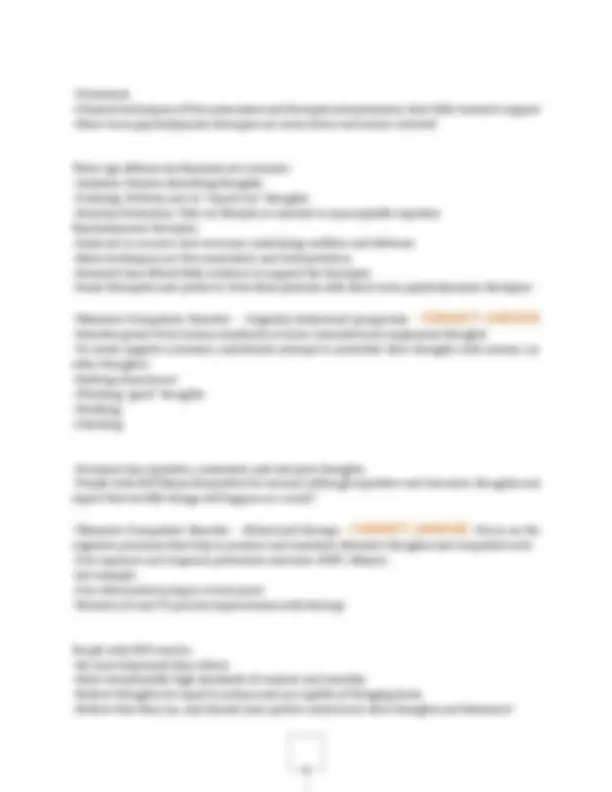
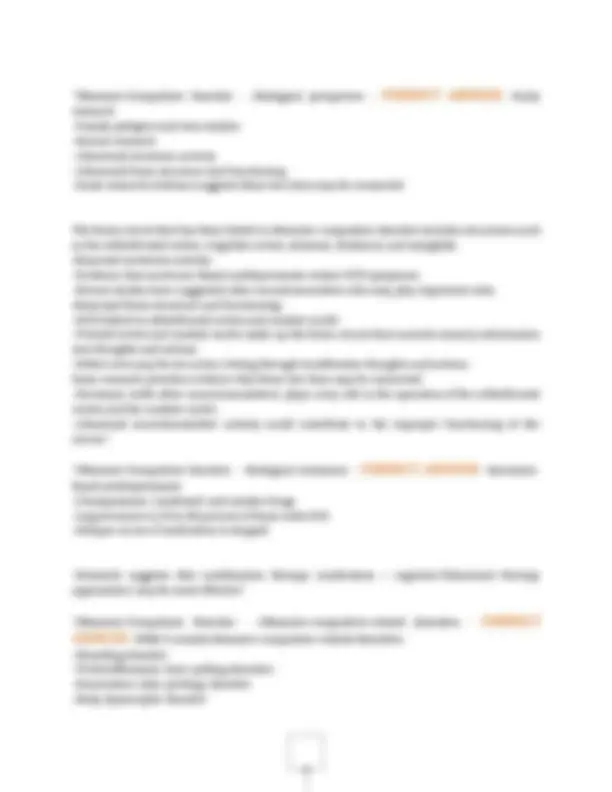
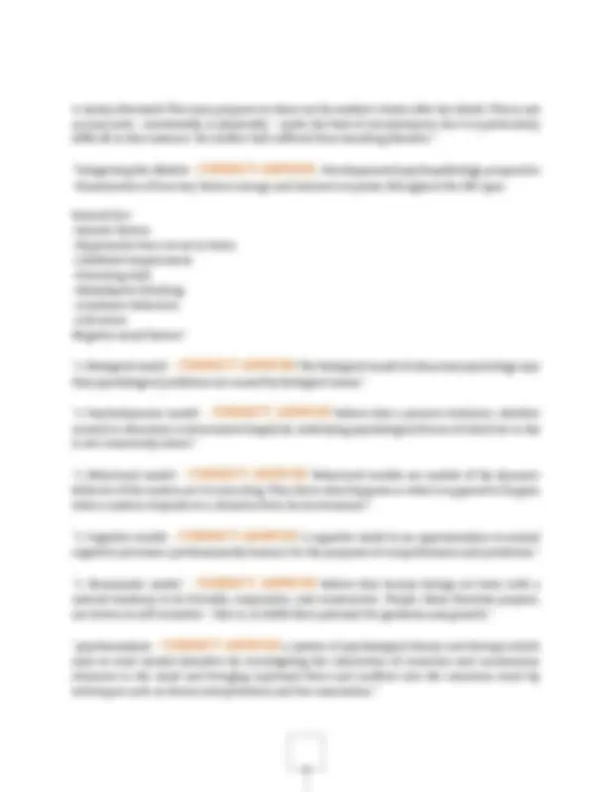
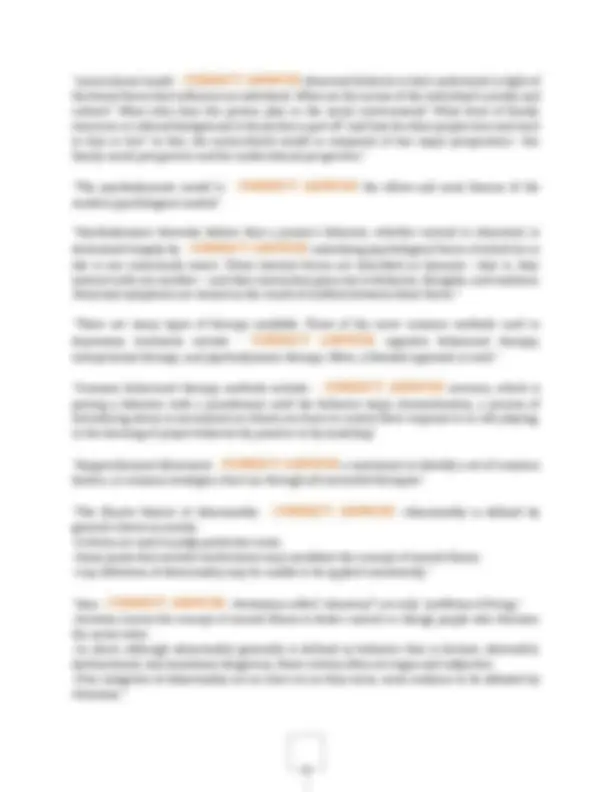
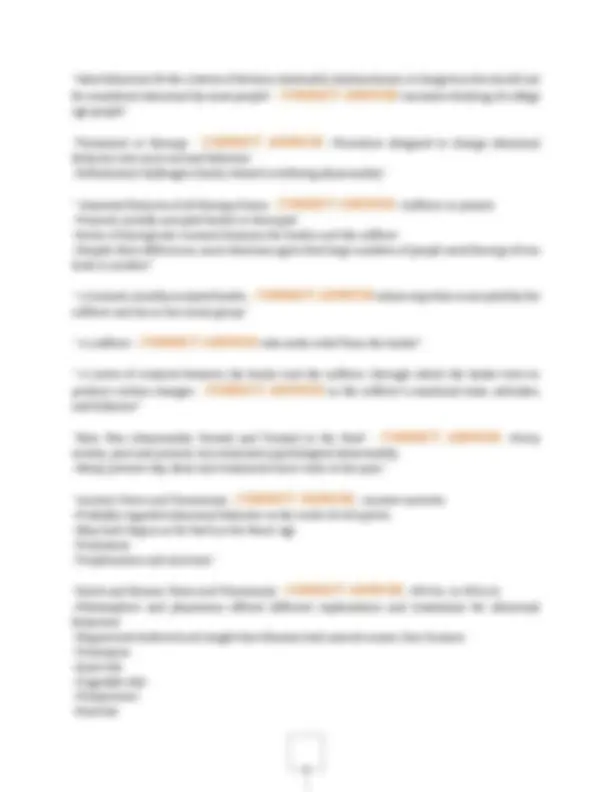
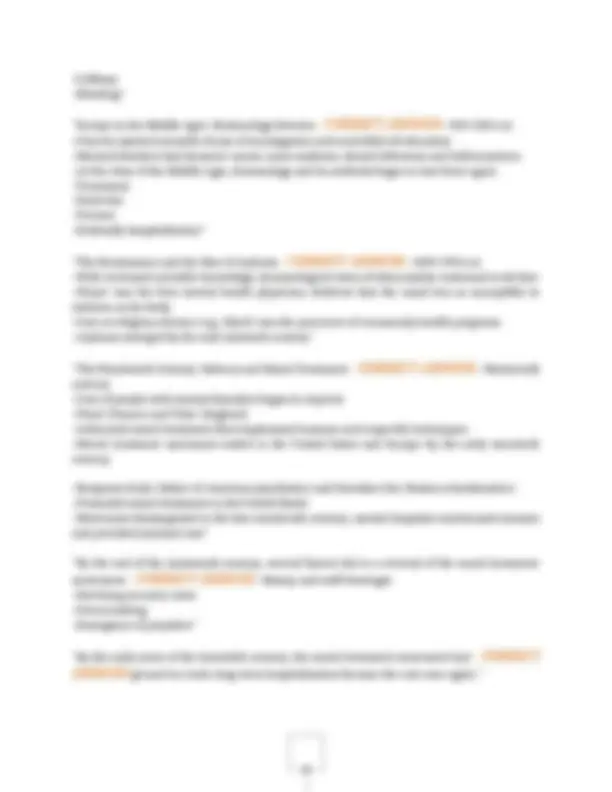
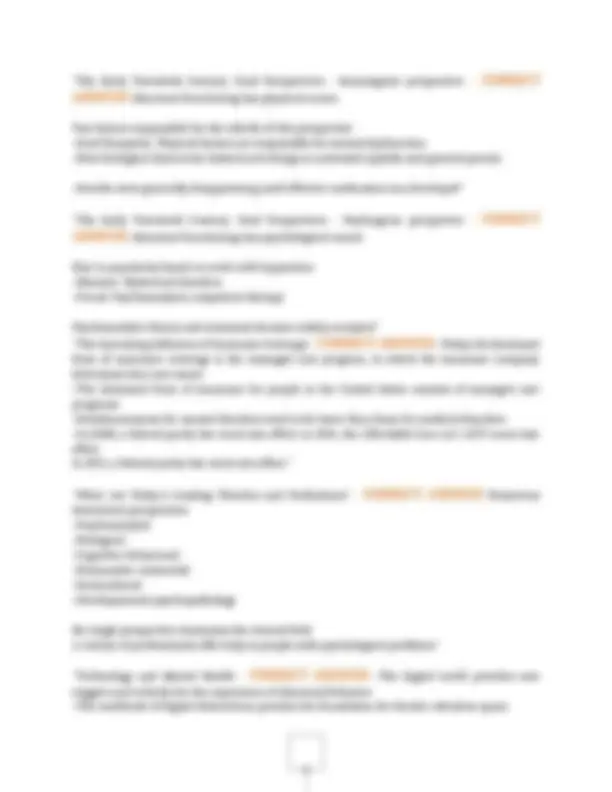
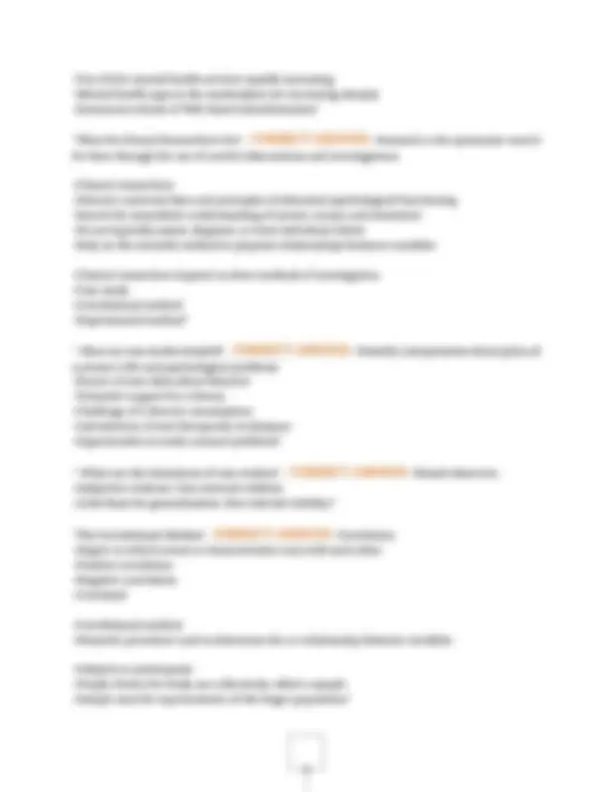
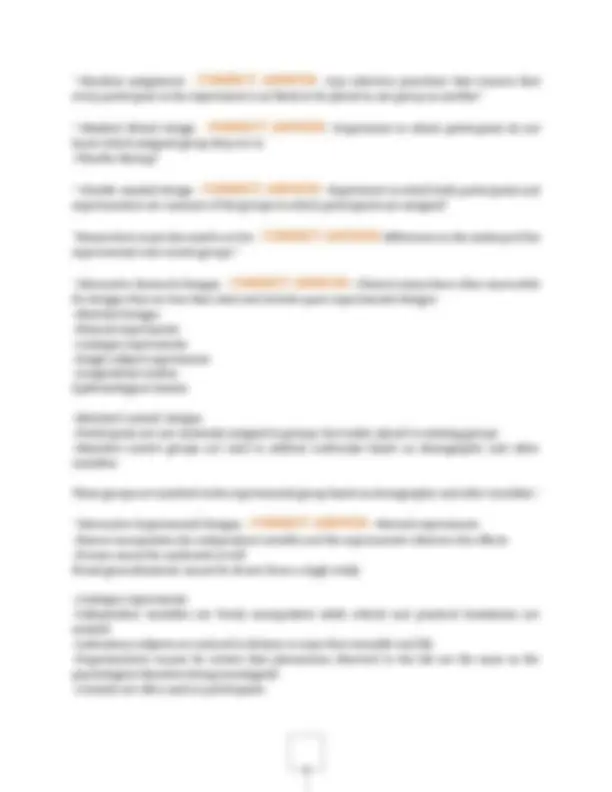
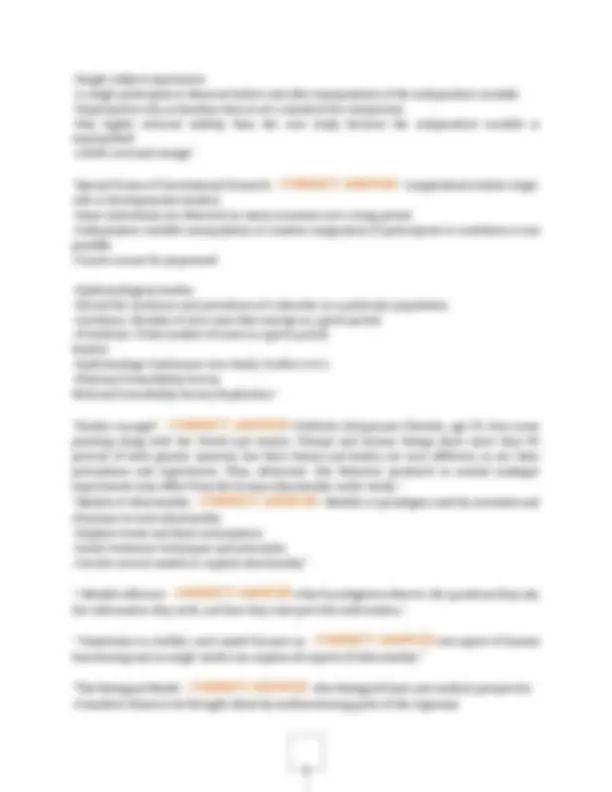
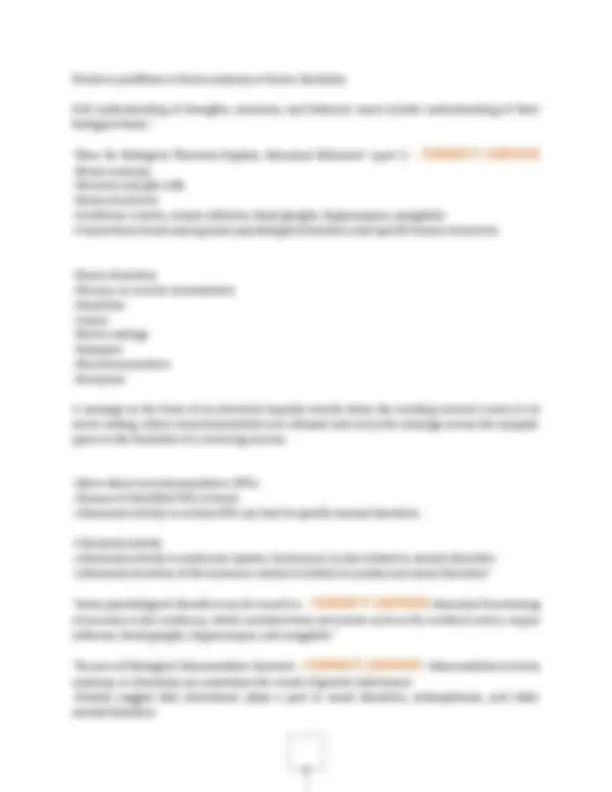
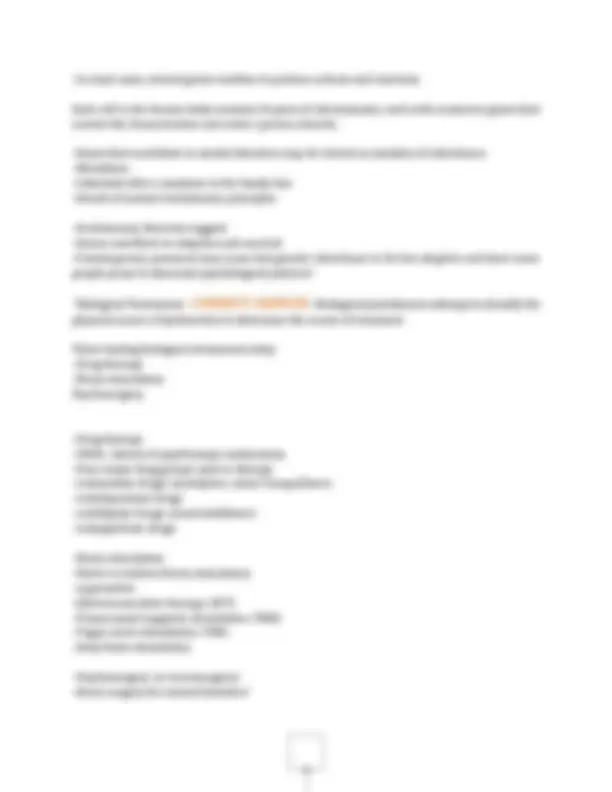
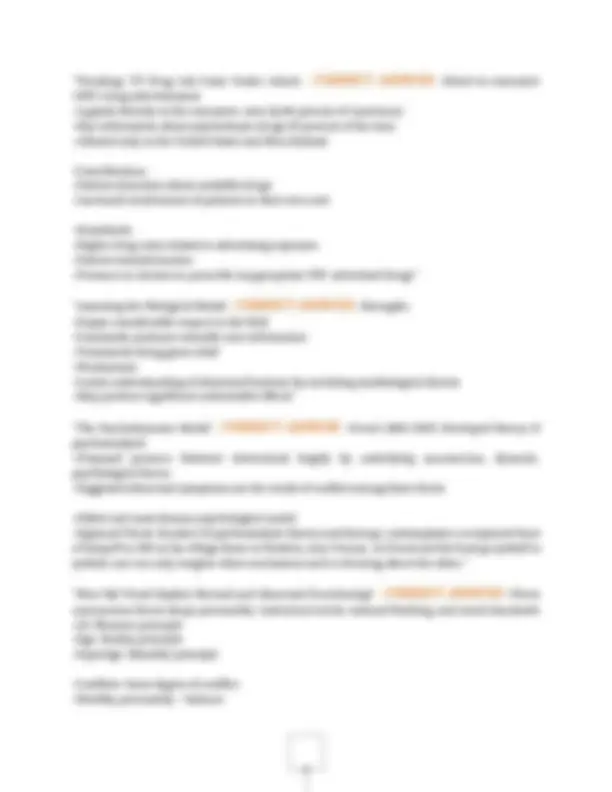
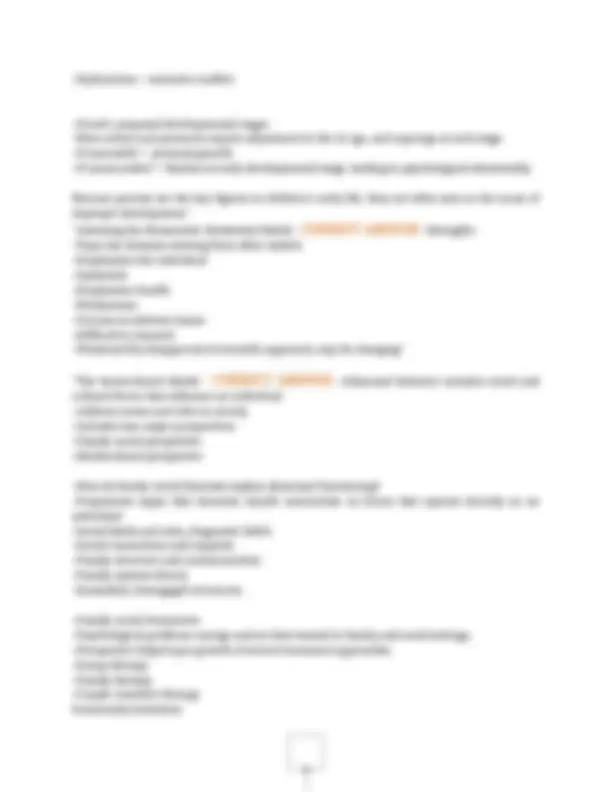
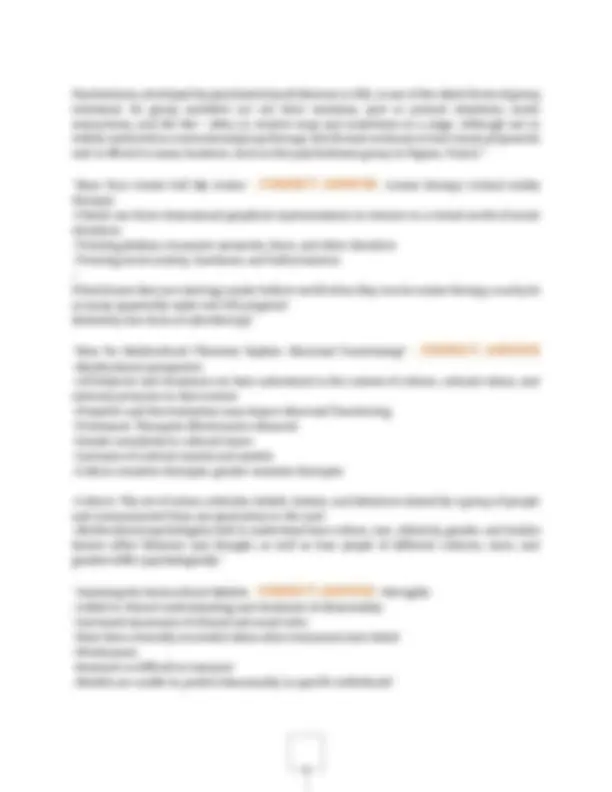
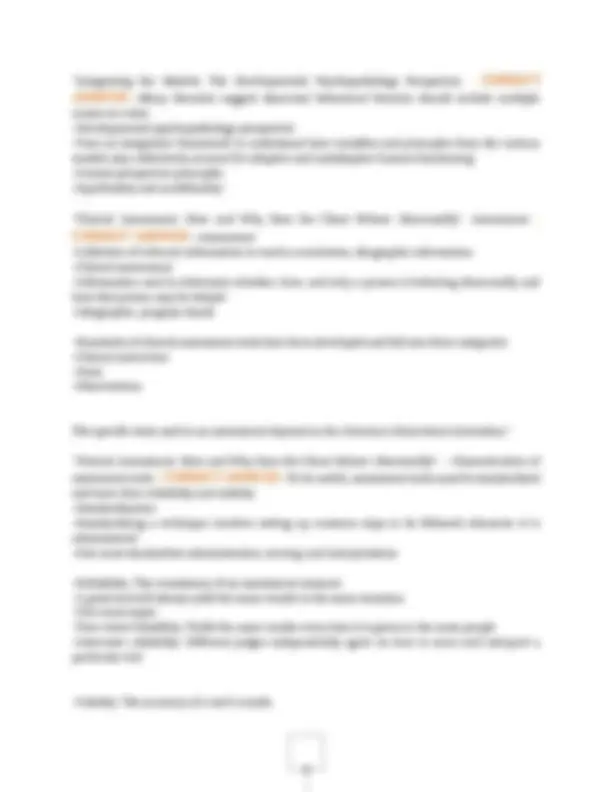
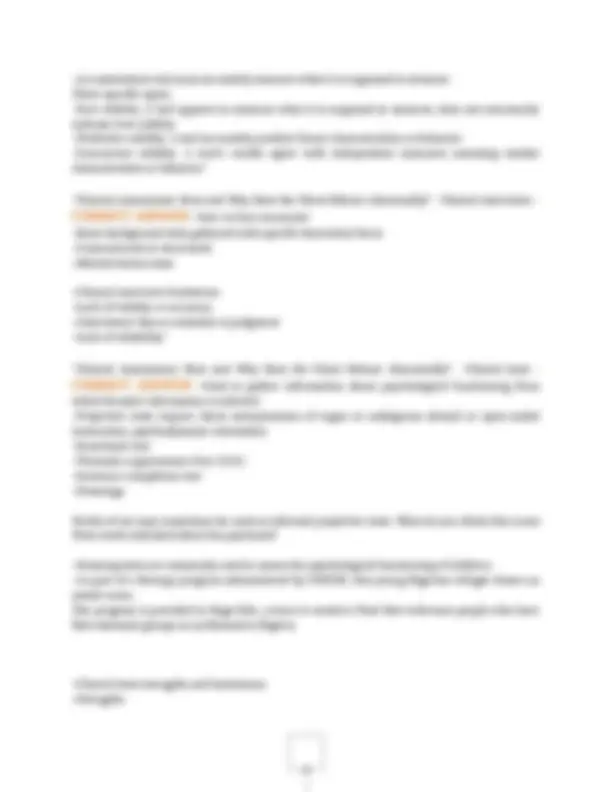
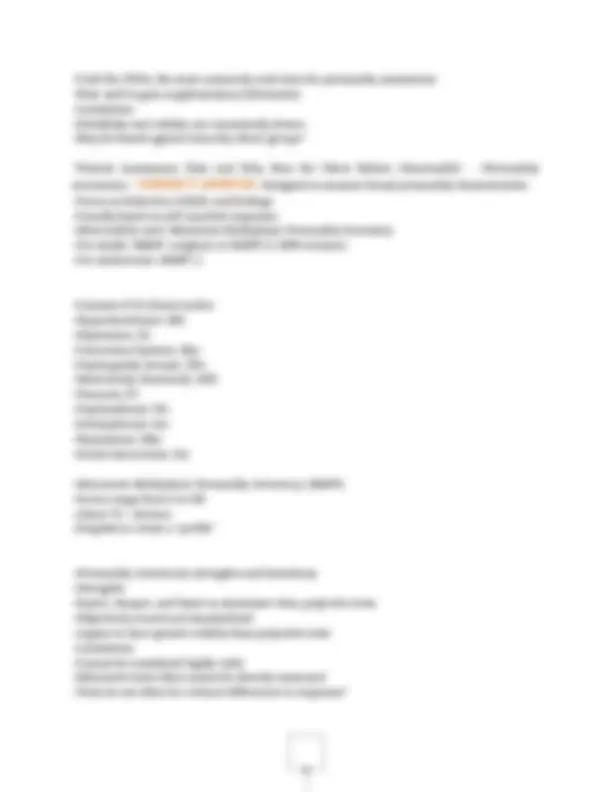
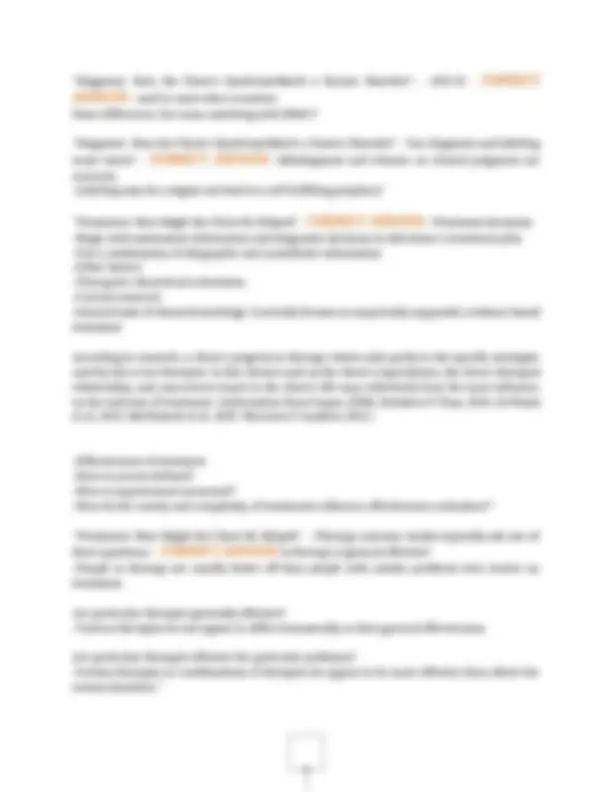
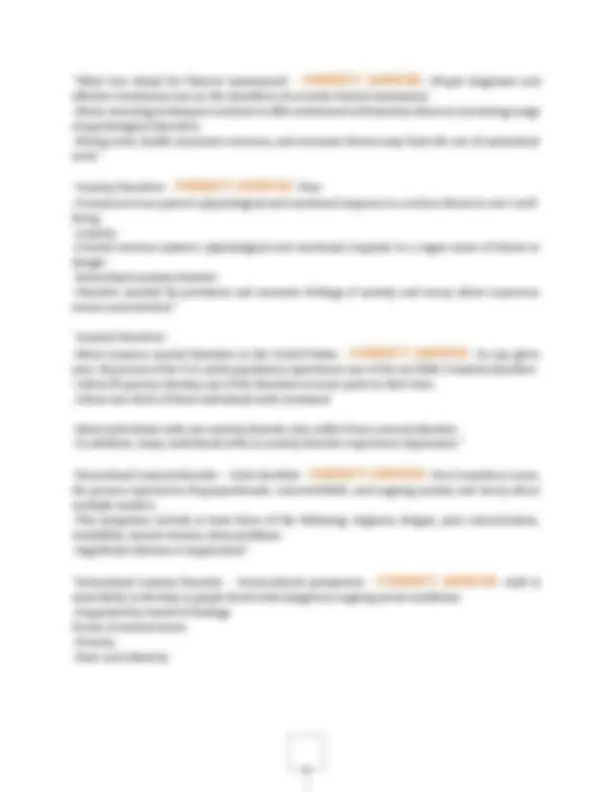
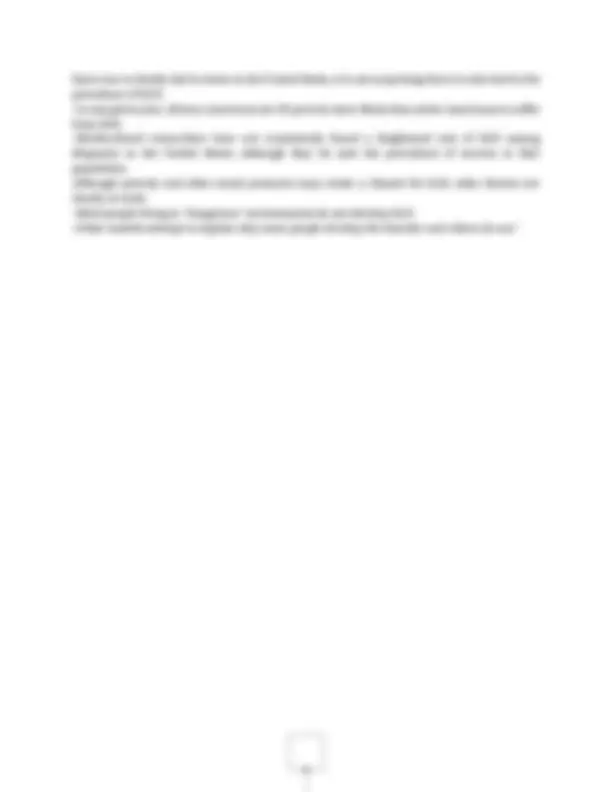


Study with the several resources on Docsity

Earn points by helping other students or get them with a premium plan


Prepare for your exams
Study with the several resources on Docsity

Earn points to download
Earn points by helping other students or get them with a premium plan
Community
Ask the community for help and clear up your study doubts
Discover the best universities in your country according to Docsity users
Free resources
Download our free guides on studying techniques, anxiety management strategies, and thesis advice from Docsity tutors
ABNORMAL PSYCHOLOGY - EXAM 1 - CHAPTER 1-4 QUESTIONS AND COMPLETE SOLUTIONS
Typology: Exams
1 / 43

This page cannot be seen from the preview
Don't miss anything!




































effort to describe, predict, explain, and change abnormal patterns of functioning •Many definitions have been proposed, yet none has won total acceptance"
Clinical practitioners"
Deviance Distress Dysfunction Danger Influences Norms Culture Context"
exist, but there have been major changes in the last 60 years in the ways clinicians understand and treat abnormal functioning: •More theories and treatment types •More research and information •More disagreements about abnormal functioning"
disorders upon themselves; 35% consider mental health disorders to be caused by sinful behavior."
psychotropic medications discovered in 1950s •Antipsychotic drugs •Antidepressant drugs •Antianxiety drugs Led to deinstitutionalization and rise in outpatient care"
Drugs that mainly affect the brain and reduce many symptoms of mental dysfunction. •The number of patients (around 42,000) now hospitalized in public mental hospitals in the United States is a small fraction of the number hospitalized in 1955. (Information from Lang, 1999; Smith & Milazzo-Sayre, 2014; Torrey, 2001.)"
•Almost all outpatient care took the form of private psychotherapy •Today •Outpatient care is the primary mode of treatment; more insurance coverage •Prevention programs are increasing; positive psychology has grown •Programs dealing with one kind of psychological problem have been created"
response to the growing diversity of the United States •Multicultural psychologists seek to understand how culture, race, ethnicity, gender, and similar factors affect behavior and thought and how people of different cultures, races, and genders may differ psychologically"
correlation"
based on a statistical analysis of probability •Statistical significance: The finding is unlikely to have occurred by chance •Generally, confidence increases with the size of the sample and the magnitude of the correlation"
correlational method •Has high external validity (can generalize findings) •Can repeat (replicate) studies with other samples •Difficulties with correlational studies •Lack internal validity •Describe but do not explain a relationship or causation"
•The benefits of the study outweigh its costs/risks. •The participants are protected from physical and psychological harm. •The participants have access to information about the study. •The participants' privacy is protected by principles such as confidentiality or anonymity."
points in his life underscore the logic behind longitudinal studies. Just as this person's eyes, nose, and overall smile at the age of 5 seem to predict similar facial features at the ages of 35 and 55, so too might an individual's early temperament, sociability, or other psychological features sometimes predict adult characteristics. In some longitudinal studies, clinical researchers have found that a number of children who seem to be at particular risk for psychological disorders do indeed develop such disorders at later stages of their lives."
increasingly turned to social networks for their studies •An area that has raised ethical concerns involves the direct and secret manipulation of social media users by researchers •A core problem for all social media studies is that most social media sites do not really have policies prohibiting researchers from studying subscribers or subscriber profiles without clear permission •Can an argument be made that ethical standards for studies using the Internet and social media should be different from those applied to other kinds of research?"
Clinton offers an official apology to 94-year-old Herman Shaw and other African American men whose syphilis went untreated by government doctors and researchers in the Tuskegee Syphilis Study, a research undertaking conducted from 1932 to 1972, prior to the emergence of Institutional Review Boards. In this infamous study, 399 participants were not informed that they had the disease, and they continued to go untreated even after it was discovered that penicillin is an effective intervention for syphilis."
•Despite differences, each theory posits human functioning is shaped by dynamic (interacting) forces •Self theorists •Emphasize the unified personality •Object-relations theorists •Emphasize the human need for relationships, especially between children and caregivers"
conflicts with the therapist acting as a guide
•Free association •Therapist interpretation •Resistance •Transference •Dream interpretation •Catharsis •Working through •Current trends •Short-term psychodynamic therapies •Relational psychoanalytic therapy •"
•First to recognize the importance of psychological theories and systematic treatment for abnormality •Saw abnormal functioning nested in the same processes as normal functioning •Weaknesses •Unsupported ideas; difficult to research •Non-observable concepts •Inaccessible to human subjects (unconscious)"
and/or cognitions in understanding and treating psychological abnormality •Shares key principles between behavioral and cognitive perspectives •Readily accessible, observable, reportable human functioning •Empirical studies conducted in laboratories or the field, rather than case studies •Action-oriented, instructional, present-focused, directive, and structured therapies •Behavioral dimension •Using conditioning •Classical conditioning •Modeling •Operant conditioning •Therapists, as teachers, seek to help replace problematic behaviors with more appropriate behaviors
•Weaknesses •Precise role of cognition in abnormality has yet to be determined •Therapies do not help everyone •Some changes may not be possible to achieve •A new wave of therapies has emerged •Acceptance and commitment therapy Mindfulness-based techniques"
•Emphasis on people as friendly, cooperative, and constructive •Focus on drive to self-actualize through honest recognition of strengths and weaknesses •Existentialist view •Emphasis on accurate self-awareness and meaningful life (authentic) •Total freedom from birth can result in negative or positive behaviors/outcomes •Psychological dysfunction is caused by self-deception Existential therapists do not believe that experimental methods can adequately test the effectiveness of their treatments; as a result, little controlled research has been conducted. •Rogers' humanistic theory and therapy •Basic human need for unconditional positive regard •If received → unconditional self-regard •If not → conditions of worth •Rogers' client-centered therapy •Therapist creates a supportive climate •Unconditional positive regard •Accurate empathy •Genuineness •Little research support but positive impact on clinical practice •Gestalt theory and therapy (Fritz Perls; 1950s) •Goal is to guide clients toward self-recognition through challenge and frustration Techniques •Skillful frustration •Role playing •Rules, including "here and now" and "I" language •Little research support; subjective experiences and self-awareness cannot be objectively measured
•Spiritual views and interventions •Historical alienation between the clinical field and religion seems to be ending •Researchers suggest spirituality can correlate with psychological health •Many clinicians now encourage use of spiritual resources to cope with stressors For most of the twentieth century, clinical scientists viewed religion as a negative—or at best neutral—factor in mental health. •Existential theories and therapy •Psychological abnormality •Arises when client uses self-deception to hide from responsibilities •Clients feel overwhelmed by societal for"
brain structure and activity •Examples: EEG, PET scans, CT scans, MRI, fMRI Family EEG As part of a study conducted at York University in Toronto, a mother and her 5- yearold autistic child play, socialize, and share tasks while wearing nets containing EEG sensors. The electrodes attached to their scalps help measure their brain waves, and these measurements are later compared to those derived from other mothers and their non-autistic children during similar interactions. •Neuropsychological tests indirectly assess brain function by assessing cognitive, perceptual, and motor functioning •Example: Bender Visual-Motor Gestalt Test •Clinicians often use a battery of tests •Intelligence tests •Designed to indirectly measure intellectual ability •Typically consist of a series of tests assessing both verbal and nonverbal skills •General score is an intelligence quotient (IQ) •Represents the ratio of a person's "mental" age to his or her "chronological" age •Are among the most carefully produced of all clinical tests •Highly standardized on large groups of subjects •Have very high reliability and validity •Weaknesses •Performance can be influenced by nonintelligence •Tests may contain cultural biases in language or tasks •Members of minority groups may have less experience and be less comfortable with these types of tests, influencing their results"
•A determination that a person's psychological problems constitute a particular disorder •Based on an existing classification system Influenced by the clinician's theoretical orientation •In North America and around the world, the DSM faces competition from two other diagnostic systems •International Classification of Disorders (ICD) •Research Domain Criteria (RDoC)"
•Lists of categories, disorders, and symptom descriptions, with guidelines for assignment •Focus on clusters of symptoms (syndromes) •DSM-5 requires clinicians to provide both categorical and dimensional information as part of a proper diagnosis •Categorical information: The name of the category (disorder) indicated by the client's symptoms. •Dimensional information: A rating of how severe a client's symptoms are and how dysfunctional the client is across various dimensions of personality •DSM-5 categorical information Anxiety disorders •Generalized anxiety disorder; social anxiety disorder; panic disorder; separation anxiety disorder Depressive disorders •Major depressive disorder; persistent depressive disorder; premenstrual dysphoric disorder •DSM-5 dimensional information •Assessment of current client disorder severity •Rating scales for each disorder •Cross-Cutting Symptom Measure •Emotional Distress-Depression Scale Is DSM-5 an effective classification system? •Predictive validity is most used clinically •DSM-5 has greater validity than any previous edition •Validity is still a concern
•The framers of DSM-5 followed certain procedures in their development of the new manual to help ensure that DSM-5 would have greater reliability than the previous DSMs. •A number of new diagnostic criteria and categories were developed, with the expectation that the new criteria and categories would be reliable. •Some critics continue to have concerns about the procedures used in the development of DSM-5. •The DSM-5 changes that have raised the most concern include the following: •Major depressive disorder and recent bereavement •Premenstrual dysphoric disorder category •Somatic symptom disorder category •Combination of patterns into single substance use disorder •Gambling disorder c"
young children •DSM-5 determined separation anxiety can develop in adults •New categorization as an anxiety disorder is controversial"
posited that all children experience anxiety •Realistic anxiety when they face actual danger •Neurotic anxiety when they are prevented from expressing id impulses •Moral anxiety when they are punished for expressing id impulses •Some children experience particularly high levels of anxiety or their defense mechanisms are particularly inadequate Today's psychodynamic theorists often disagree with specific aspects of Freud's explanation. Researchers have found some support for the psychodynamic perspective: •People with GAD are particularly likely to use defense mechanisms (especially repression). •Adults, who as children suffered extreme punishment for expressing id impulses, have higher levels of anxiety later in life. Some scientists question whether these studies show what they claim to show. Psychodynamic therapies •Free association •Therapist interpretations of transference, resistance, and dreams Specific treatments for GAD •Freudians focus less on fear and more on control of id
•Metacognitive theory (Wells) and meta-worries •Intolerance of uncertainty theory (Koerner and colleagues) •Avoidance theory (Borkovec) How Long Do Your Worries Last? In one survey, 62 percent of college students said they spend less than 10 minutes at a time worrying about something. In contrast, 20 percent worry for more than an hour. (Information from Tallis, 2015, 2014; Tallis et al., 1994.) In recent years, several new explanations have emerged: •Metacognitive theory: Developed by Wells; suggests that the most problematic assumptions in GAD are the individual's worry about worrying (meta-worry) •Uncertainty theory: Certain individuals consider it unacceptable that negative events may occur, even if the possibility is very small; they worry in an effort to find "corr"
•Changing maladaptive assumptions •Ellis's rational-emotive therapy (RET) Breaking down worrying •Mindfulness-based cognitive-behavioral therapy •Acceptance and commitment therapy •"
chiefly by biological factors •Supported by family pedigree studies and brain researchers •Challenged by competing explanation of shared environment •Fear reactions are tied to brain circuits •Biological relatives more likely to have GAD (approximately 15 percent): The closer the relative, the greater the likelihood. •There is, however, a competing explanation of shared environment. •GAD results from a hyperactive fear circuit •GABA: Important neurotransmitter in this circuit Involves several brain structures •Prefrontal cortex •Anterior cingulate cortex •Insula •Amygdala
•Bed nucleus of stria terminals (BNST) may play large or larger role than other structures The Biology of Anxiety The circuit in the brain that helps produce anxiety reactions includes structures such as the amygdala, prefrontal cortex, anterior cingulate cortex, and insula (not visible from this view of the brain). In normal fear reactions: •Key neurons fire more rapidly, creating a general state of excitability experienced as fear or anxiety. •A feedback system is triggered, so that brain and body activities work to reduce excitability. •Some neurons release GABA to inhibit neuron firing, thereby reducing experience of fear or anxiety. Malfunctions in the feedback system are believed to cause GAD. •Possible reasons: Too few receptors, ineffective receptors Recent research has complicated the picture: •Other neurotransmitters also bind to GABA receptors. Issue of causal relationships: •Do physiological events CAUSE anxiety? •How can we know? •What are alternative explanations? •Drug therapy •Early 1950s: Barbiturates (sedative-hypnotics) •Late 1950s: Benzodiazepines •More recently: Antidepressant and antipsychotic medications Benzodiazepines: •Provide temporary, modest relief •Rebound anxiety with withdrawal and cessation of us"
•A normal and common experience •How do phobias differ from fear? •More intense and persistent fear •Greater desire to avoid the feared object or situation •Create distress that interferes with functioning Categories of phobias •Specific phobias •Agoraphobia
behavioral explanations •Cognitive-behavioral theory •Behavioral-evolutionary explanation Phobias, not Although these young women cling tightly to each other, frozen with fear as they try to walk across a bridge, they are not displaying abnormal fear or a phobia. A closer look reveals that the bridge, which stands 600 feet high and spans 1000 feet, has a glass floor, the first of its kind in China. Almost all visitors to this new tourist destination initially experience the same emotional reaction— overwhelming and near-paralyzing fear."
Classical conditioning •US: Entrapment à UR: Fear •CS: Running water à CR: Fear Modeling •Observation •Imitation Phobias develop through modeling: •Observation and imitation Phobias are maintained through avoidance. Phobias may develop into GAD when a person acquires a large number of them. •Process of stimulus generalization: Responses to one stimulus are also elicited by similar stimuli. What does research indicate? •Early laboratory studies of classical conditioning of fear: Watson and Rayner (Little Albert) •Modeling: Bandura and Rosenthal Fear reactions not always conditioned •McGabe and Gamble and colleagues •Disorder not ordinarily acquired through classical conditioning or modeling"
phobias are much more common than others •Species-specific biological predisposition to develop certain fears: preparedness •Explains why some phobias (snakes, spiders) are more common than others (meat, houses)
•Is a mouse's fear of cats a conditioned reaction or genetically hardwired? Scientists at Tokyo University used genetic engineering to switch off this rodent's instinct to cower at the smell or presence of cats. But mouse beware! The cat has not been genetically engineered to act in a corresponding manner. •Treatments for specific phobias •Actual contact with the feared object or situation is key to greater success in all forms of exposure treatment •Systematic desensitization (Wolpe) •Covert and in vivo desensitization, including virtual reality •Flooding Modeling Since relaxation is incompatible with fear, the relaxation response is thought to substitute for the fear response. •Teach relaxation skills → Create fear hierarchy → Pair relaxation with the feared objects or situations •Types: •In vivo desensitization (live) •Covert desensitization (imaginal)"
successful •Newer, more successful treatments Variety of exposure therapy approaches •Support groups •Home-based self-help programs •Are successful for about 70 percent of agoraphobic clients Relapses may occur, especially when panic disorder also exists •Often explained in ways similar to specific phobias •Many people with agoraphobia experience extreme and sudden explosions of fear, called panic attacks, •Such individuals may receive two diagnoses—agoraphobia and panic disorder."
population •13 percent of people experience symptoms during lifetime •Non-Hispanic white Americans more likely to experience than African, Hispanic, or Asian Americans •Often begins in late childhood or adolescence and into adulthood
•Social skills training groups and assertiveness training groups allow clients to practice their skills with other group members."
produce more common forms of anxiety, including social and generalized anxiety Facebook, Instagram, or Snapchat"
occur suddenly, reach a peak within minutes, and gradually pass •Feature at least four of the following symptoms of panic: •Heart palpitations •Tingling in the hands or feet •Shortness of breath •Sweating •Hot and cold flashes •Trembling •Chest pains •Choking sensations •Faintness •Dizziness Feeling of unreality (APA, 2013) •Women are twice as likely as men to be affected. •Poor people are 50 percent more likely than wealthier people to experience these disorders. •The prevalence is the same across cultural and racial groups in the United States and seems to occur in cultures across the world. •Approximately 35 percent of persons with panic disorder are in treatment."
yearly •More than 5 percent of people experience symptoms during lifetime •Often begins in late adolescence or early adulthood •Non-Hispanic white Americans more likely to experience than U.S. racial-ethnic minority groups •59 percent seek treatment •May be accompanied by agoraphobia •Checklist •Unforeseen panic attacks occur repeatedly •One or more of the attacks precede either of the following symptoms: •At least a month of continual concern about having additional attacks
•At least a month of dysfunctional behavior changes associated with the attacks (e.g., avoiding new experiences)"
•Panic attacks caused by abnormal norepinephrine activity in locus coeruleus •More recent theory •Brain circuits and amygdala are the more complex root of the problem •May be an inherited predisposition to abnormalities in these areas •Caused by a hyperactive panic circuit •Amygdala •Hippocampus •Ventromedial nucleus of hypothalamus •Central gray matter Locus coeruleus The Biology of Panic The circuit in the brain that helps produce panic reactions includes structures such as the amygdala, hippocampus, ventromedial nucleus of the hypothalamus, central gray matter, and locus coeruleus."
improvement to more than two-thirds of patients •Function in norepinephrine receptors in the panic brain circuit •Improvements require maintenance of drug therapy •Some benzodiazepines (especially Xanax [alprazolam]) have proved helpful"
are only part of the cause of panic attacks •Bodily sensations are misinterpreted as signs of medical catastrophe and controlled by avoidance and safety behaviors •Anxiety sensitivity may exist •Biological challenge test •Procedure used to produce panic and assess panic disorder Misinterpreting bodily sensations •Panic-prone people may be very sensitive to certain bodily sensations and may misinterpret them as signs of a medical catastrophe; this leads to panic. •Why might some people be prone to such misinterpretations? •Experience more frequent or intense bodily sensations •Have experienced more trauma-filled events •Whatever the precise cause, panic-prone people generally have a high degree of "anxiety sensitivity."